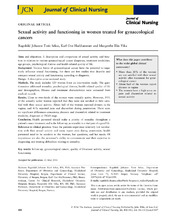| dc.contributor.author | Sekse, Ragnhild Johanne Tveit | en_US |
| dc.contributor.author | Hufthammer, Karl Ove | en_US |
| dc.contributor.author | Vika, Margrethe Elin | en_US |
| dc.date.accessioned | 2017-04-28T11:24:52Z | |
| dc.date.available | 2017-04-28T11:24:52Z | |
| dc.date.issued | 2017-02 | |
| dc.Published | Sekse RJT, Hufthammer KO, Vika ME. Sexual activity and functioning in women treated for gynaecological cancers. Journal of Clinical Nursing. 2017;26(3-4):400-410 | eng |
| dc.identifier.issn | 0962-1067 | |
| dc.identifier.uri | https://hdl.handle.net/1956/15752 | |
| dc.description.abstract | Aims and objectives. A description and comparison of sexual activity and function in relation to various gynaecological cancer diagnoses, treatment modalities, age groups, psychological distress and health-related quality of life. Background. Various forms of gynaecological cancer have the potential to negatively influence sexual functioning, but there are few studies that describe and compare sexual activity and functioning according to diagnosis. Design. A descriptive cross-sectional study. Methods. The study includes 129 women from an intervention study. The questionnaires addressed sexuality, psychological distress, health-related quality of life and demographics. Disease and treatment characteristics were extracted from medical records. Results. Close to two-thirds of the women were sexually active. However, 54% of the sexually active women reported that they were not satisfied or little satis- fied with their sexual activity. About half of the women reported dryness in the vagina, and 41% reported pain and discomfort during penetration. There were no significant differences concerning pleasure and discomfort related to treatment modality, diagnoses or FIGO stage. Conclusion. Health personnel should make a priority of sexuality throughout a patient’s cancer treatment and in the follow-up, as sexuality is a vital part of a good life. Relevance to clinical practice. Since the patients experience relatively low satisfaction with their sexual activity and many report pain during penetration, health personnel need to be sensitive to the woman, her questions, and her needs. Of importance are also the personnel’s ability to communicate and their expertise in diagnosing and treating difficulties relating to sexuality. | en_US |
| dc.language.iso | eng | eng |
| dc.publisher | Wiley | eng |
| dc.rights | Attribution CC BY-NC-ND | eng |
| dc.rights.uri | http://creativecommons.org/licenses/by-nc-nd/4.0/ | eng |
| dc.subject | follow-up | eng |
| dc.subject | gynaecological cancer | eng |
| dc.subject | quality of lifesexual activity | eng |
| dc.subject | sexual functioning | eng |
| dc.title | Sexual activity and functioning in women treated for gynaecological cancers | en_US |
| dc.type | Peer reviewed | |
| dc.type | Journal article | |
| dc.date.updated | 2017-04-19T06:52:15Z | |
| dc.description.version | publishedVersion | en_US |
| dc.rights.holder | Copyright 2016 The Author(s) | |
| dc.identifier.doi | https://doi.org/10.1111/jocn.13407 | |
| dc.identifier.cristin | 1459493 | |
| dc.source.journal | Journal of Clinical Nursing | |

